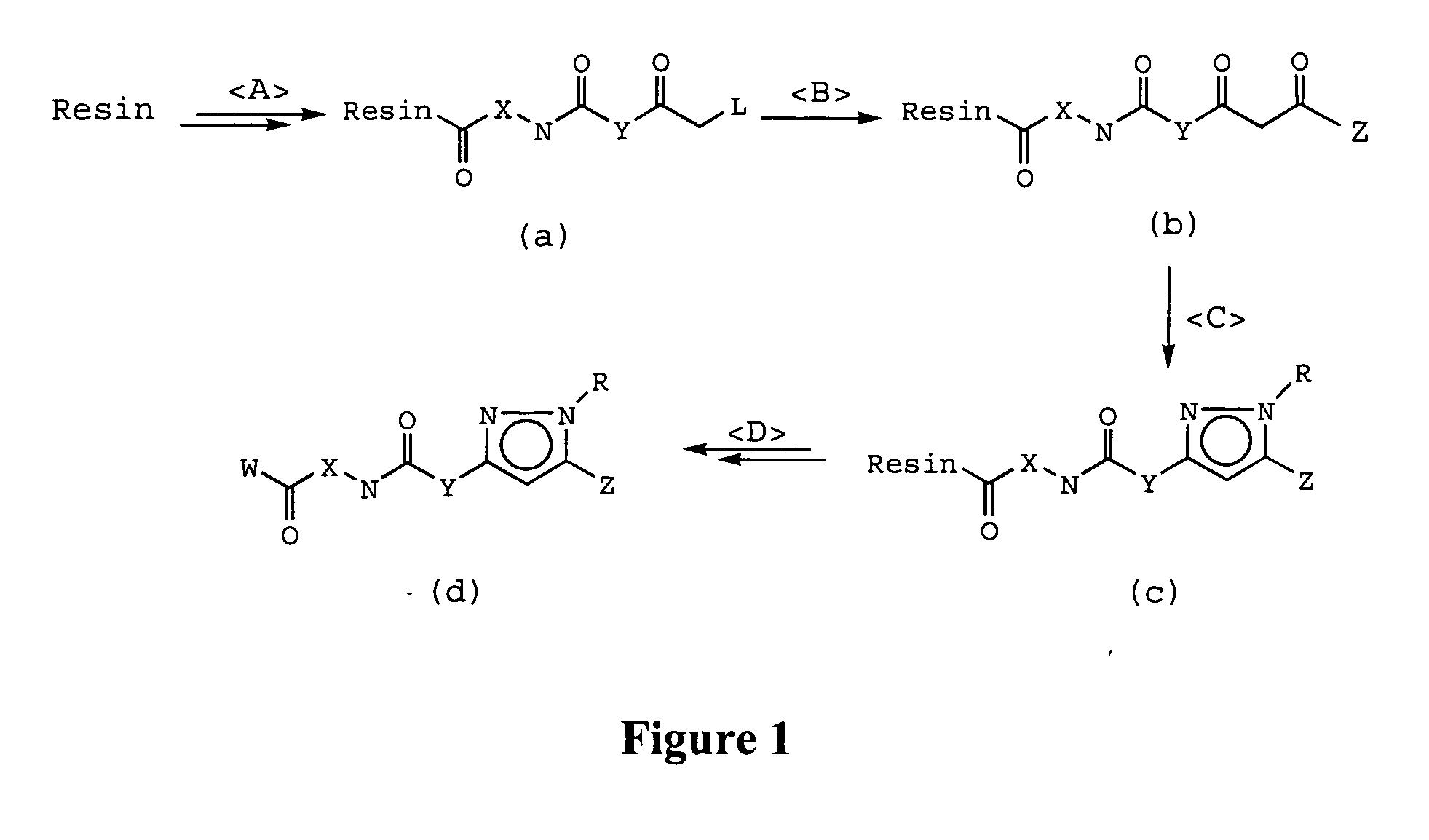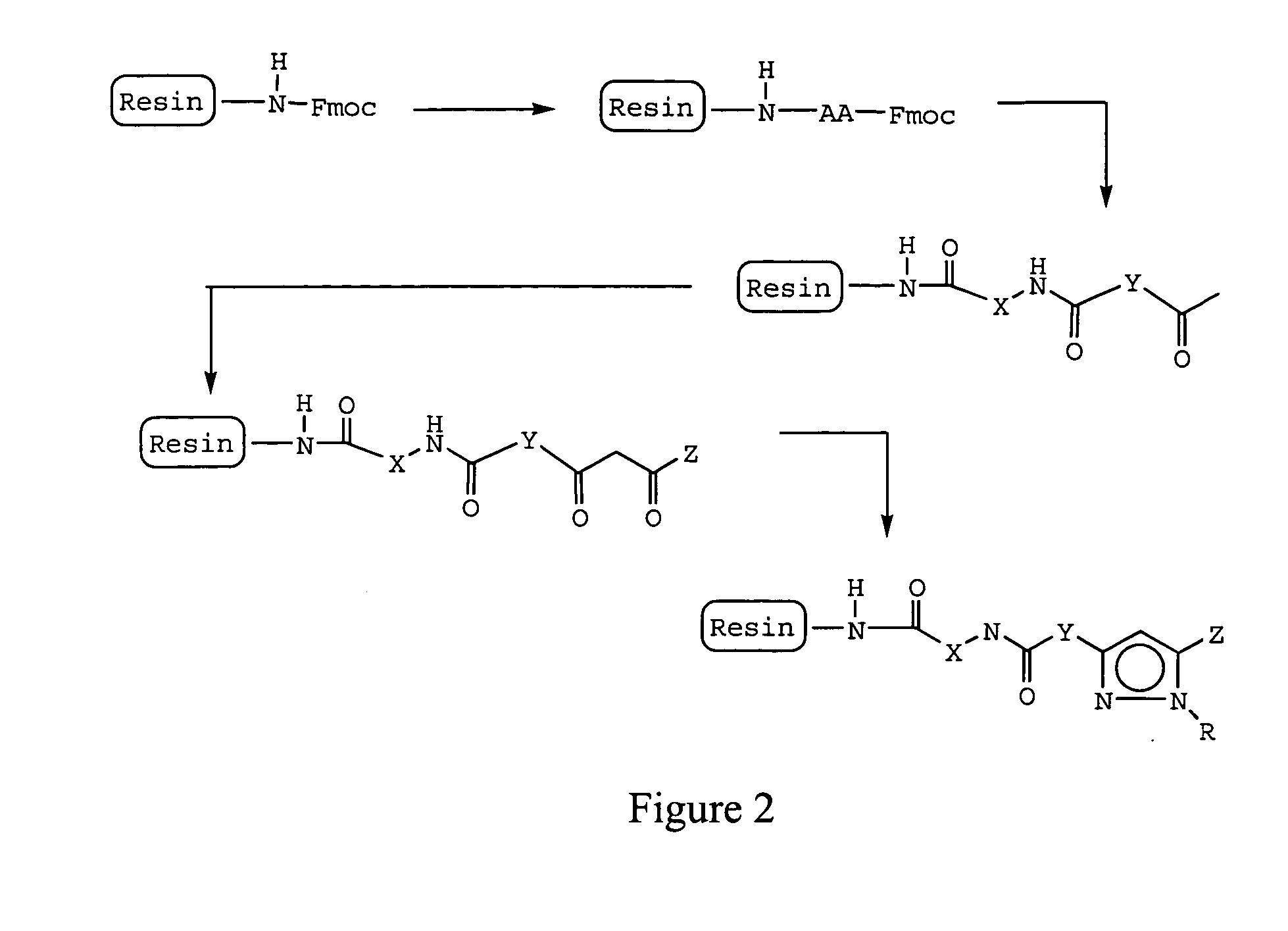Prenylation inhibitors containing dimethylcyclobutane and methods of their synthesis and use
a technology of dimethylcyclobutane and inhibitors, which is applied in the field of compound compounds, can solve the problems of difficult synthesizing and purifying, lethal to fungal cells, and affecting the integrity of cell walls
- Summary
- Abstract
- Description
- Claims
- Application Information
AI Technical Summary
Benefits of technology
Problems solved by technology
Method used
Image
Examples
example 1
This example illustrates methods for synthesizing compounds of the present invention.
Coupling to Polystyrene Rink resin
About 42 grams (g) of Fmoc-protected Rink polystyrene resin and about 100 milliliter (ml) of dimethylformamide (DMF) were combined in a 500 ml peptide vessel and shaken for about 5 minutes. The DMF was removed, about 200 ml of 20% piperidine in DMF was added to the vessel, and the mixture was shaken for 30 minutes. This step was repeated prior to the solvent being removed. Following removal of the solvent, the resin was deprotected by being washed 3 times with 30 ml of DMF and twice with 200 ml of 1-methyl-2-pyrrolidinone (NMP). The resin was then dried for about 1 hour in vacuo. About 2 equivalents of an amino acid, about 2 equivalents of benzotriazol-1-yl-oxy-tris-pyrrolidino-phosphonium hexafluorophosphate (PyBOP), about 2 equivalents of N-hydroxybenzotriazole (HOBt), and about 200 ml of NMP were mixed in a 250 ml beaker. Before addition to the peptide vesse...
example 2
This example shows the formation of the pyrazole ring having different substituents. Referring to FIG. 4, the individual intermediates were formed under the following reaction conditions.
2-Hydroxy4-oxo4-pyridin-3-ylbut-2-enoic acid methyl ester (1). Acetyl pyridine (1.81 mL, 16.5 mmol) and methyl oxalate (3.12 g, 26.4 mmol) were dissolved in MeOH (30 mL, anhydrous). Sodium methoxide (6.9 mL, 25% in MeOH) was added over 10 min. Reaction solidified and was complete after 15 minutes. The solid mass was dissolved when acidified with HCl (10%, aqueous). The pH was then adjusted with NH4OH (conc) until precipitation ceased. The resulting solid was taken up in EtOAc. The aqueous layer was removed and extracted twice with EtOAc. The combined EtOAc layers were washed with water and brine, dried over MgSO4, filtered, and concentrated in vacuo. Collected 1 (2.90 g, 85%) as an off-white solid.
1-(3,4-Dichlorophenyl)-5-pyridin-3-yl-1H-pyrazole-3-carboxylic acid methyl ester hydrochloride (2)...
example 3
This example demonstrates the synthesis of prenylation inhibitors of the present invention with different substituent on the pyrazole ring. Referring to FIG. 5, the individual intermediates were formed under the following reaction conditions.
(12). NaOEt (21% w / v EtOH; 2.04 g, 30 mmol) was added to a dry flask under N2. The mixture was cooled to 0C. During the cooling process, ethyl nicotinate (4.53 g, 30 mmol) was added in one portion. y-Butyrolactone (2.58 g, 30 mmol) was added dropwise over 30 min. The mixture was stirred at 0° C. for 1 h. Upon removal of the ice bath the reaction was allowed to warm to rt and was heated to ˜65° C. overnight. The solvent was removed in vacuo and the residue was diluted with H2O, and extracted with diethyl ether to remove any unreacted starting material. The aqueous phase was acidified with 1N HCl and extracted with DCM. The organic layer was washed with H2O, brine, and dried (Na2SO4), to yield 12 (2.87 g, 50%) as a brown oil.
(13). To a soluti...
PUM
| Property | Measurement | Unit |
|---|---|---|
| chemical structure | aaaaa | aaaaa |
| structures | aaaaa | aaaaa |
| nucleic acid sequence | aaaaa | aaaaa |
Abstract
Description
Claims
Application Information
 Login to View More
Login to View More - R&D Engineer
- R&D Manager
- IP Professional
- Industry Leading Data Capabilities
- Powerful AI technology
- Patent DNA Extraction
Browse by: Latest US Patents, China's latest patents, Technical Efficacy Thesaurus, Application Domain, Technology Topic, Popular Technical Reports.
© 2024 PatSnap. All rights reserved.Legal|Privacy policy|Modern Slavery Act Transparency Statement|Sitemap|About US| Contact US: help@patsnap.com










